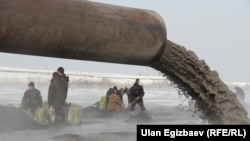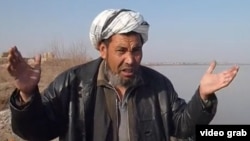
Central Asia is known for many reasons but two things stand out in coverage of the region these days -- the geostrategic location in terms of security and its energy resources.
Coverage of Central Asia’s energy resources almost always features adjectives such as “vast,” “huge,” and “massive.”
Central Asia has oil and natural gas, Kazakhstan is the world’s leading uranium producer (more than 20,000 tons in 2013), much has been made of the hydropower potential in the southeastern mountains, and then there is the great promise of developing solar power in the south and wind power in the northern steppe.
So why is coal such a rapidly developing source of power domestically?
The reasons vary from country to country, and while some reasons are perhaps understandable, other reasons are the result of failed inter-regional politics and policies that prioritize exports over domestic needs.
But first, how “massive” is Central Asia’s energy potential?
For the purpose of comparison, I’m choosing France, despite far greater industrialization, because its population is roughly the same as that of Central Asia (if the 4-8 million Central Asian migrant laborers were back home). That would be, some 66 million people. *
My sources are the U.S. Energy Information Agency and the BP statistical review of world energy from June 2013, so if you disagree with these figures send your hate mail to them, not to me. And I know most people don’t like a lot of numbers, so I’ll keep this brief.
Mountainous Kyrgyzstan and Tajikistan are Central Asia’s hydropower kings. They have an estimated combined potential, barely tapped, to generate some 460 billion kWh of electricity per year. France uses about 500 billion kWh annually.
Kazakhstan has the lion’s share of Central Asia’s oil reserves but combined with Turkmenistan and Uzbekistan they have about 37 billion barrels of oil. France consumes about 1.7 million barrels per day.
Turkmenistan has the bulk of natural gas but combined with Kazakhstan and Uzbekistan they have some 19.9 trillion cubic meters of gas. France uses some 43 billion cubic meters annually.
And for what it’s worth, the Uzbek government website says the country has solar power potential to generate as much energy as some 50 billion barrels of oil equivalent.
So there seems to be enough to go around for the people of Central Asia.
Okay, so why is coal production/consumption rising in Kazakhstan, Kyrgyzstan, Tajikistan and Uzbekistan?
The easy explanation is there is a lot of coal in Central Asia and it fed Soviet-era thermal power plants across the region except in Turkmenistan, which uses almost exclusively natural gas for its power. Many of those plants, which in some cases date back to the 1950s and 1960s, are still operating today.
Kazakhstan is the most interesting -- to me anyway. Called the “oil baron” of Central Asia, at least 64 percent, and by some estimates nearly 80 percent, of Kazakhstan’s electricity is produced by coal-fired plants.
The “massive” Ekibastuz coalfield in northern Kazakhstan has an estimated 13 billion tons of coal, and together with the country’s other coal deposits, give Kazakhstan about 4 percent of the world’s coal.
Kazakhstan’s industrial northeast and the Almaty commercial hub of the country in the southeast are far from the oil and gas fields of western Kazakhstan. Oil and gas are starting to make their way eastward, in large part due to newly constructed pipelines that continue on to China.
But it’s not enough to fill the needs of eastern Kazakhstan, where most of the country’s people live.
The Ekibastuz-1 and Ekibatus-2 thermal plants provide power to the capital Astana and industrial cities such as Pavlodar, Karaganda, and Ekibastuz.
Work has started on a new thermal plant near the shore of Lake Balkhash. Once completed it will help supply electricity south to the Almaty area. The Balkhash plant is a compromise, substituting for a planned nuclear power plant at Balkhash that was scrapped after a public outcry.
Kazakhstan’s coal consumption rose from some 87 million tons in 2008 to some 94.5 million tons by 2012.
Kyrgyzstan and Tajikistan have the same reason for increasing their coal production and consumption: they are tired of purchasing gas from neighboring Uzbekistan.
Uzbekistan has repeatedly cut off gas to the two neighbors, sometimes for debts the two countries regularly incur, and sometimes to show displeasure with political decisions in Bishkek and Dushanbe.
Tajik MPs Mahmadsharif Haqdodov and Haqnazar Boboev visited RFE/RL's Tajik Service, Ozodi, last September and said straight out the reason for switching to coal was the problem negotiating gas with Uzbekistan.
Both Kyrgyzstan and Tajikistan have deposits of coal, Tajikistan especially with 4.5 billion tons. The Tajik embassy website claims the country has coal reserves “sufficient for about 200 years.”
Tajikistan announced in early 2013 that it was converting its plants and factories to power from coal-fueled plants, and started upgrading existing thermal power plants, such as the one in Dushanbe. As of July last year the government claimed all the country’s major enterprises were using coal for power.
Between 2008 and 2011, Tajikistan’s coal consumption was almost static at around 230,000 to 235,000 tons. In 2013, Tajikistan produced 518,000 tons of coal.
Kyrgyzstan has followed Tajikistan’s lead.
Kyrgyzstan consumed 1.1 million tons of coal in 2008 and in 2011 (last EIA figure available) used some 1.55 million tons, a good portion of it imported from Kazakhstan. In 2013, Kyrgyzstan produced some 1.425 million tons of coal, which still leaves the country short by about 500,000 tons of being able to fuel thermal plants in the northern part of the country.
Uzbekistan is a mystery. Just over a decade ago gas was so cheap and so plentiful that when I asked a friend in the Tashkent area one day why he left his gas stove burning he told me “gas is cheap but it’s hard to find matches.”
Gas is scarce now for some reason (Uzbekistan has some 1.1 trillion cubic meters of gas), and Uzbekistan is also increasing production and consumption of coal. Coal consumption was actually going down from nearly 3.9 million tons in 2008 to 3.2 million tons in 2012.
That has changed quickly. Last November the first stage of the Angren coal production complex project was completed. Production is expected to double at the huge open-pit mining site and reach 6.4 million tons annually. Of that, some 4.6 million tons will be used as fuel in the Novo-Angren thermal power plant.
Uzbek officials said the additional power from the Angren plant would free up some 800 million cubic meters of gas annually, which apparently hasn't started yet judging from recent reports of gas shortages in Uzbekistan.
State plans call for raising the share of coal in Uzbekistan’s fuel balance from the current 3.9 percent to 11 to 12 percent by 2016.
I guess they don’t show those pictures of Chinese cities on smoggy days.
Coal is certainly abundant and capable of filling the power needs of the Central Asian countries. But with all the options available, from cleaner burning fossil fuels to renewable energy sources, it is strange so much money (several billion dollars) is being invested into developing the coal industry.
This is due to the governments' policy of exporting lucrative energy resources to get the money and leaving their own people to depend on a cheaper and dirtier source of energy.
Coming soon: a look at Central Asian energy exports.










